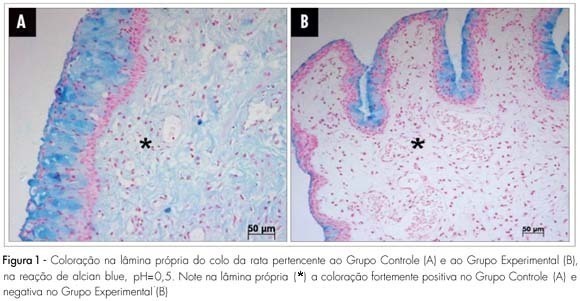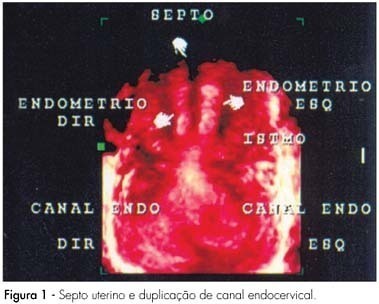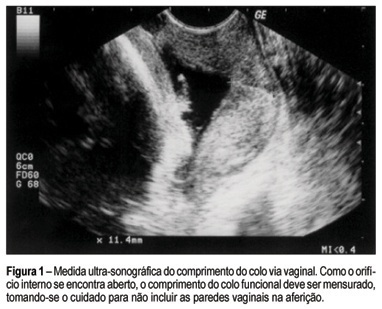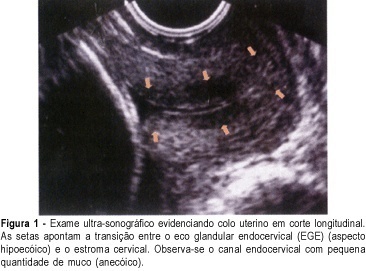Summary
Revista Brasileira de Ginecologia e Obstetrícia. 2008;30(7):328-334
DOI 10.1590/S0100-72032008000700002
PURPOSE: to study the histochemical changes related to the uterine cervix glycosaminoglycan of the albino female rat, after local ministration of hyaluronidases at the end of pregnancy. METHODS: ten female rats with positive pregnancy tests were randomly distributed in two numerically equal groups. The control group (Cg) was built up with rats that received a single dose of 1 mL of distilled water in the uterine cervix, under anesthesia, at the 18th pregnancy day. In the experimental group (Exg), the rats received 0.02 mL of hyaluronidase, diluted in 0.98 mL of distilled water (1 mL as a total), under the same conditions as the Cg. At the 20th pregnancy day, the rats were anesthetized once again and submitted to dissection, and the cervix prepared for histochemical study with alcian blue dye and its blockades (pH=0.5, pH=2.5, methylation and saponification). RESULTS: strongly positive reaction in the lamina propria (+3) has been seen in the Cg, and negative reaction in the Exg, with pH=0.5 alcian blue staining. With pH=2.5, staining has also been strongly positive (+4) in the Cg, and weakly positive (+1) in the Exg slide. After methylation, both groups have shown negative reaction, with pH=2.5 alcian blue staining. The lamina propria staining became negative after methylation in both groups, followed by saponification and enzymatic digestion on slide. CONCLUSIONS: there is clear predominance of sulphated glycosaminoglycans in the Cg as compared to the Exg and a small amount of identified carboxylated glycosaminoglycans in the Exg. The changes evidenced in the extracellular matrix have suggested that the hyaluronidase injected in the uterine cervix has promoted biochemical changes compatible with cervix maturation.

Summary
Revista Brasileira de Ginecologia e Obstetrícia. 2007;29(11):588-592
DOI 10.1590/S0100-72032007001100007
This report describes an unusual case of spontaneous pregnancy in a patient with Müllerian anomaly. The patient was a 34-years old, white, nulligravida, with regular menstrual cycles, and suspected uterine septum observed during a routine ultrasonographic examination. The gynecological examination revealed a complete longitudinal vaginal septum and two uterine cervices. Three-dimensional pelvic ultrasonography showed cervix duplication, uterine septum from isthmus to endometrial cavity and absence of uterine body division, compatible with complete uterine septum and true dual cervices. She returned after one month and reported unprotected sexual intercourse and delayed menstrual period. She was pregnant, had a good pregnancy evolution, and delivered a healthy term baby girl, by cesarean section, at 37 weeks of pregnancy. This report describes a case of normal-term pregnancy in a patient with a rare anomaly (vaginal septum and two cervices) who became spontaneously pregnant without treatment.

Summary
Revista Brasileira de Ginecologia e Obstetrícia. 2006;28(11):664-670
DOI 10.1590/S0100-72032006001100006
PURPOSE: to assess the role of ultrasonographic cervical length in predicting premature labor in patients presenting persistent uterine contractions and intact membranes. METHODS: a prospective observational cohort study was performed in 45 women admitted to our hospital between 22 and 34 weeks of gestation. Transvaginal sonographic evaluation of the cervix was performed once in the women who had completed a course of parenteral tocolysis. The cervical length was obtained according to criteria reported previously. Cervical sonographic findings were not used in diagnosis and management. Outcome variable was the occurrence of preterm delivery (<37 weeks). Statistical analysis consisted of univariate method with the purpose of determining the significant contribution of cervical length to the prediction of preterm delivery. The adopted significance level was 5% (p<0,05) and the confidence interval was 95% (95% CI). RESULTS: the incidence of preterm delivery was 51.11% (23/45). Cervical length was significantly associated with the outcome (p<0.0001). Receiver operating characteristic curve analysis showed that a cervical length of 20 mm was the best cutoff in predicting preterm delivery (sensitivity 86.9%; specificity 81.8%; positive predictive value 83.3%; negative predictive value 85.7%). The calculated area under the curve was 0.91 (95% CI: 0.79-0.97; p<0.0001). CONCLUSIONS: among women with persistent uterine contractions and intact membranes treated for preterm labor, a cervical length of less than 20 mm demonstrated a high likelihood of preterm birth. Transvaginal ultrasound may improve the accuracy of diagnosis in symptomatic women.

Summary
Revista Brasileira de Ginecologia e Obstetrícia. 2006;28(11):633-642
DOI 10.1590/S0100-72032006001100002
PURPOSE: to verify the sensitivity, specificity and accuracy of some ultrasonographic measurements in the diagnosis of stress urinary incontinence (SUI). METHODS: transvaginal ultrasound measurements of the bladder neck descent, urethral mobility and urethrovesical funneling caused by urination effort were performed in 40 women with SUI and in 40 women from a control group. Age, parity and the number of pregnancies were different in both groups. Several cut points were performed to evaluate the sensitivity, specificity and accuracy of these measurements as a diagnostic tool for SUI. The urodynamic results were used as gold standard. Univariated analysis was done using Yates chi2 Test and Pearson chi2 Test. RESULTS: in the best cut point for bladder neck descent measurements, sensitivity was 40%, specificity was 72% and accuracy was 57%; in the best cut point for urethral mobility measurements, sensitivity was 40%, specificity was 70% and accuracy was 55%; in the best cut point for urethrovesical funneling measurements, sensitivity was 58%, specificity was 48% and accuracy was 52%; in the best cut point for the addition of the differences of these three measurements, sensitivity was 32%, specificity was 62% and accuracy was 48%. CONCLUSION: vaginal ultrasonography was not a valid diagnostic method for stress urinary incontinence in the present study.

Summary
Revista Brasileira de Ginecologia e Obstetrícia. 2006;28(7):397-402
DOI 10.1590/S0100-72032006000700004
PURPOSE: to compare the uterine cervix measurements and funneling obtained by two- and three-dimensional transvaginal sonography during pregnancy. METHODS: a prospective, descriptive study, with group comparison, was carried out between April 2004 and February 2005 in 74 pregnant women, who were between the 19th and 24th week of pregnancy, regardless of risk factors for premature delivery. The ultrasound examination of the cervix was carried out only once in the same patient and by only one observer. The measurements of the cervix by two-dimensional ultrasound were made at the time of the test and by three-dimensional ultrasound at intervals of 7 to 15 days after the two-dimensional ultrasound. The measurements of cervical length, funnel width and length were taken by two-dimensional ultrasound in the sagittal plane and by three-dimensional in the sagittal plane as well as in coronal plane. RESULTS: there was no significant difference between the averages of the measurements of the cervix obtained by two- and three-dimensional ultrasound in the sagittal plane (p=0.23); however, there was a difference in the averages of the measurements of the cervix obtained by two-dimensional ultrasound in sagittal plane and three-dimensional ultrasound in the coronal plane (p=0.009) and between three-dimensional ultrasound in the sagittal and coronal planes (p=0.001). The kappa test (0.86) showed no superiority of either the two-dimensional and three-dimensional ultrasound in the visualization of the cervical funnel. No statistically significant difference was observed between the methods when the average of the measurements of funneling was compared (p>0.05). CONCLUSION: there were differences between two-dimensional and three-dimensional ultrasound of cervical length, only using the coronal plane of the three-dimensional ultrasound.
Summary
Revista Brasileira de Ginecologia e Obstetrícia. 2004;26(3):193-200
DOI 10.1590/S0100-72032004000300004
PURPOSE: to verify the prevalence of two sonographic findings, the cervical gland area (CGA) feature and the cervical length of less than 20 mm, and to compare these with the risk for premature delivery in pregnant women between 21 and 24 weeks' gestation. METHOD: this was a prospective, cross-sectional study in which 361 women were consecutively examined by transvaginal ultrasonography. Müllerian or other malformations, multiple gestations, fetal death, olygo- or polyhydramnios, marginal placenta previa, and conization, cerclage, amputation or other surgical procedures in the cervix, prior to or during pregnancy, were exclusion criteria. After the abdominal ultrasonographic morphological examination, we used transvaginal ultrasonography to measure the cervical length and to observe the presence of hyper- or hypoechoic area next to the endocervical canal, a feature characteristic of endocervical epithelium glands which is called CGA (cervical gland area). Qualitative variables are expressed as absolute and relative frequency. Quantitative variables are expressed as mean, median, standard deviation, minimum, and maximum values. Association between qualitative variables was detected by the c² test or by the Fisher exact test. For each variable, the relative risk and the 95% confidence interval (CI) were calculated. Logistic regression analysis was used to calculate the predictive values for premature delivery. Significance level was 95% (alpha = 5%), with descriptive (p) values equal or lower than 0.05 considered significant. RESULTS: spontaneous preterm delivery occurred in 5.0% of the patients. Cervical length was up to 20 mm in 3.3% of all studied patients and in 27.8% of those who delivered spontaneously before the end of the pregnancy. Absence of the CGA was detected in 2.8% of all patients and in 44.4% of the women who eventually developed spontaneous preterm labor. There was a statistically significant association of absence of CGA with short cervical length (p<0.001). Absence of CGA was strongly associated with spontaneous preterm delivery (relative risk of 28.57, 95% CI 14.40-56.68). CONCLUSION: the absent CGA feature is a new morphological ultrasonographic parameter that is useful in the prediction of spontaneous preterm delivery in single gestations. Our results show that the parameter can be used as an indicator of risk for premature delivery, to be confirmed by future research.
